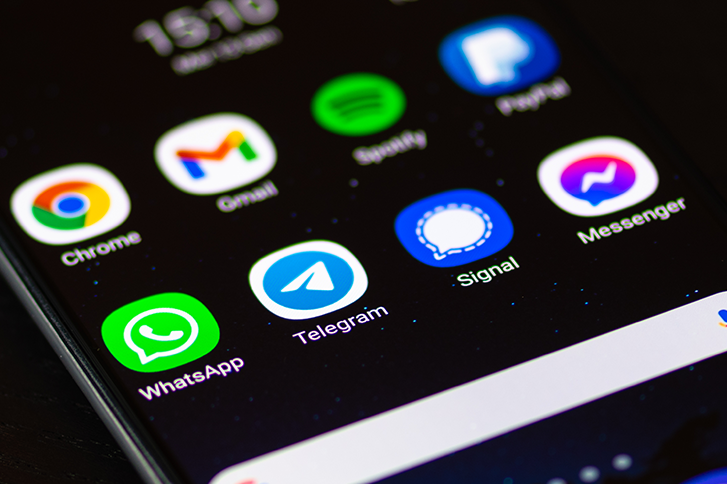When was the last time you received a text via SMS from a friend? Compare this to when you last received a text on WhatsApp or a social media platform. There is a clear shift to these platforms for personal communication and now businesses are making their move over to these platforms as well. These trends in mobile messaging may appear to indicate that the future for SMS is bleak. However current statistics completely contradict this prediction. The demand for SMS is on the rise. Let’s explore why.
How Are The Alternatives To SMS Doing?
There’s no doubt that people are looking for speed and versatility on their communication platforms. This demand has given rise to newer platforms that support multi-media messaging such as WhatsApp, WeChat and Facebook Messenger. As of January 2019, 1.5 billion users access WhatsApp on a monthly basis. The Facebook platform currently stands at 2.27 billion monthly active users, while WeChat stands at over 1 billion daily users. With users becoming increasingly comfortable with these messaging platforms it comes as no surprise that many businesses are following suit to get closer to their customers.

Some businesses like Sephora hopped onto Facebook Messenger with bot scheduling appointments for customers in their store via Facebook Messenger. While some others like KLM Royal Dutch Airlines made their way over to WhatsApp Business, WhatsApp’s new business API, enabling their passengers to communicate and make simple changes via text. Users have responded well to businesses setting the base on these platforms and the demand for businesses to move over to these other messaging platforms is expected to rise.
Where does SMS find it’s fit in the world right now?
If the demand for SMS is on the rise it’s obvious that some recent trends and developments have heavily contributed to the demand. Let’s take a look at a few of these.
1. Banking, Financial Services And Insurance (BFSI)
Banking regulations in several countries require banks to use SMS to share real-time alerts in order to catch fraudulent activity early. For example, banks now send customers text messages if a wrong pin is entered for their card. This feature has helped alert people of stolen credit card information so that they may contact the bank and take action and stop such activity in its tracks. Financial institutions have taken this a step further by enabling customers to carry out other account management activities via SMS. Customers are also informed regarding transactions made on their account. Meanwhile, social media platforms have been routinely plagued with reports of data leaks which creates a strong resistance for the banking sector to adopt them instead of SMS.
2. E-Commerce
E-Commerce has been one of the most game-changing developments of the decade that has spun several new requirements in its wake. One such requirement was a means to contact consumers and give them updates on their order’s status. While most e-commerce platforms exist as apps that have the provision for notifications and similar updates, many of these platforms choose to send important time-sensitive updates via SMS directly. This utility ranges from sending customers order confirmations to alerts on arrival and so on.
3. Verification For Mobile Applications
Several popular apps have a verification mechanism in place because they use phone numbers. WhatsApp, Uber, Zomato are some common examples. Registering an account on these apps involves a verification via SMS. These apps also communicate with the user via SMS, by sending out order confirmations, arrival alerts, feedback forms and more. Additionally, some of these apps send consumers SMS for marketing purposes. While these apps can push notifications to their users regarding the offers they still choose to do it via SMS as it is more likely to be read.
4. Additional security layer
Email service providers like Gmail have now begun insisting on an extra layer of security for email accounts by asking users to share their mobile numbers so that they may send SMS’s to help with account recovery in the unfortunate event of an issue. In the event of suspicious activity on an account, they can alert users to take action more quickly via text message than through alternate email id.
Many businesses use SMS OTP (One Time Password) for verification purposes while doing any transactions online. Messages are used by banks for communicating any type of transactions or activities on customer accounts and when withdrawing money from accounts.
What Edge Does SMS Have Over Its Newer Alternatives?
SMS has some significant advantages over its newer alternatives. These advantages have helped cement its place for certain applications. Some of the key advantages include:
No reliance on the internet: All alternatives to SMS require a Wi-Fi connection or mobile data. This raises a barrier in accessing people instantly as not all public places have Wi-Fi and mobile data plans aren’t always economical. With SMS, a person only requires a registered mobile number and a phone.
Any phone will do: The alternatives to SMS are all app based and would only work on a smartphone. While the GCC countries may boast the highest smartphone penetration in the world, the same metric in other countries is quite variable. SMS is a one-size-fits-all solution in this aspect as it can be used on any phone.
Read Rates: Read rates show that only 12% of Facebook posts and 20% of emails are read, compare this to a staggering 98% for SMS. Also factor in the average time to open SMS’s stands at 3 minutes and while that for email is 384 minutes.
Return on Investment: The high read rate coupled with the economic nature of the service yields a significantly high return on investment for businesses that deploy SMS as their means of communication.
As things stand SMS is here for the long run. While newer platforms might be better suited for certain applications like customer service, SMS is irreplaceable in its niche of instant and secure communication.



